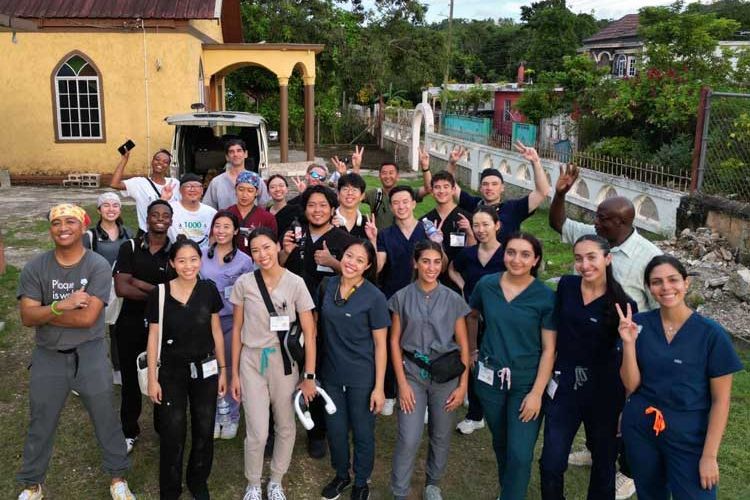Breadcrumb
Symposiums Bring Together Global Experts in Preventive and Restorative Dentistry

Speakers share insights during a panel at the Erosive Tooth Wear Symposium
Experts in Preventive and Restorative Dentistry from across the United States, Canada and the United Kingdom recently gathered for collaborative educational sessions at the Arthur A. Dugoni School of Dentistry in San Francisco.
The events brought together leading specialists to review the latest research findings, discuss new approaches to prevention and treatment, and explore ways to integrate new information into dental school curricula.
Erosive Tooth Wear Symposium
What is erosive tooth wear? When you look at your teeth, they seem solid, but actually the enamel — the outer layer of your tooth — can slowly dissolve if it’s frequently exposed to acid, such as that found in fruit juices or some carbonated drinks. This erosion starts when minerals are removed from teeth and the enamel consequently softens. The ingredients for re-hardening teeth are found in saliva — and in fluoride in toothpastes — so the softening can be repaired, but the problem is widespread and has crucial implications for oral and overall health.
“Erosive Tooth Wear is the third most common dental condition and approximately 30% of people have their tooth enamel dissolved or worn away,” said Rebecca Moazzez, BDS, MSc, PhD, FDSRCS, MRD, the chair of the Department of Preventive and Restorative Dentistry at the Dugoni School. “It is part of our duty of care to correctly detect, diagnose and manage this common oral condition. I am very pleased that we have started this work at University of the Pacific in collaboration with global colleagues to help raise awareness for patients, the public, and our fellow colleagues and students.”
Experts from the Dugoni School, King’s College London and other U.S. dental schools gathered at the Erosive Tooth Wear Symposium held Sept. 4. Speakers identified gaps in current research and provided innovative approaches to treatment and prevention. The group discussed the implications for dental education, including how the topic of erosive tooth wear is integrated into dental school curricula so the next generation of dentists will be able to recognize and manage the condition, and looked at a recent survey of U.S. and U.K. dental schools. The results as well as previous data showed that there is a need to raise awareness of the condition in the U.S.
Speakers included David Bartlett, BDS, PhD (King’s College); Jonathan Creeth, BSc, PhD (Haleon); Anderson T. Hara, DDS, MSD, PhD (Indiana University School of Dentistry); Rebecca Moazzez, BDS, MSc, PhD, FDSRCS, MRD (University of the Pacific) and Rupert Austin, BDS, PhD (King’s College).
The symposium was sponsored by Haleon through the Dugoni School’s Center for Innovation and Translation. This collaborative work will help improve awareness in the U.S., increase our understanding of the condition, and find innovative solutions for monitoring, prevention and minimally invasive management options.

Consortium of Operative Dentistry Educators (CODE) participants
Consortium of Operative Dentistry Educators
On Sept. 5-6, the Dugoni School hosted the annual meeting of the Consortium of Operative Dentistry Educators (CODE)’s Region 1. Since 1966, CODE has worked to gain agreement on the teaching of operative dentistry by fostering communication between dental schools. Region 1 includes 16 dental schools across the United States and Canada.
Each region holds an annual meeting hosted by a dental school, where CODE representatives discuss key topics for operative educators. The agenda includes core questions set by the advisory committee and national director. In addition to discussing national themes, this year speakers from the Dugoni School also shared details about the school’s integrated Helix curriculum, the Pacific Health Care Collaborative and the humanistic culture built and sustained at the school. Presentations also included an update about CDCA-ADEX licensure.
The meeting was sponsored by Garrison Dental Solutions, Planmeca Oy, Patterson Dental, Kilgore International, Ivoclar Vivadent, Vakker Dental, Kuraray Dental, Ultradent Inc., HuFriedy Group, Centrix Inc. and Acadental Inc.
“The CODE meeting is very rewarding as it provides the opportunity to discuss and share insights with colleagues from other schools in the region on various topics relevant to operative dentistry,” said Dr. Moazzez. “It was an absolute pleasure to host the CODE family for our annual meeting at our school.”





